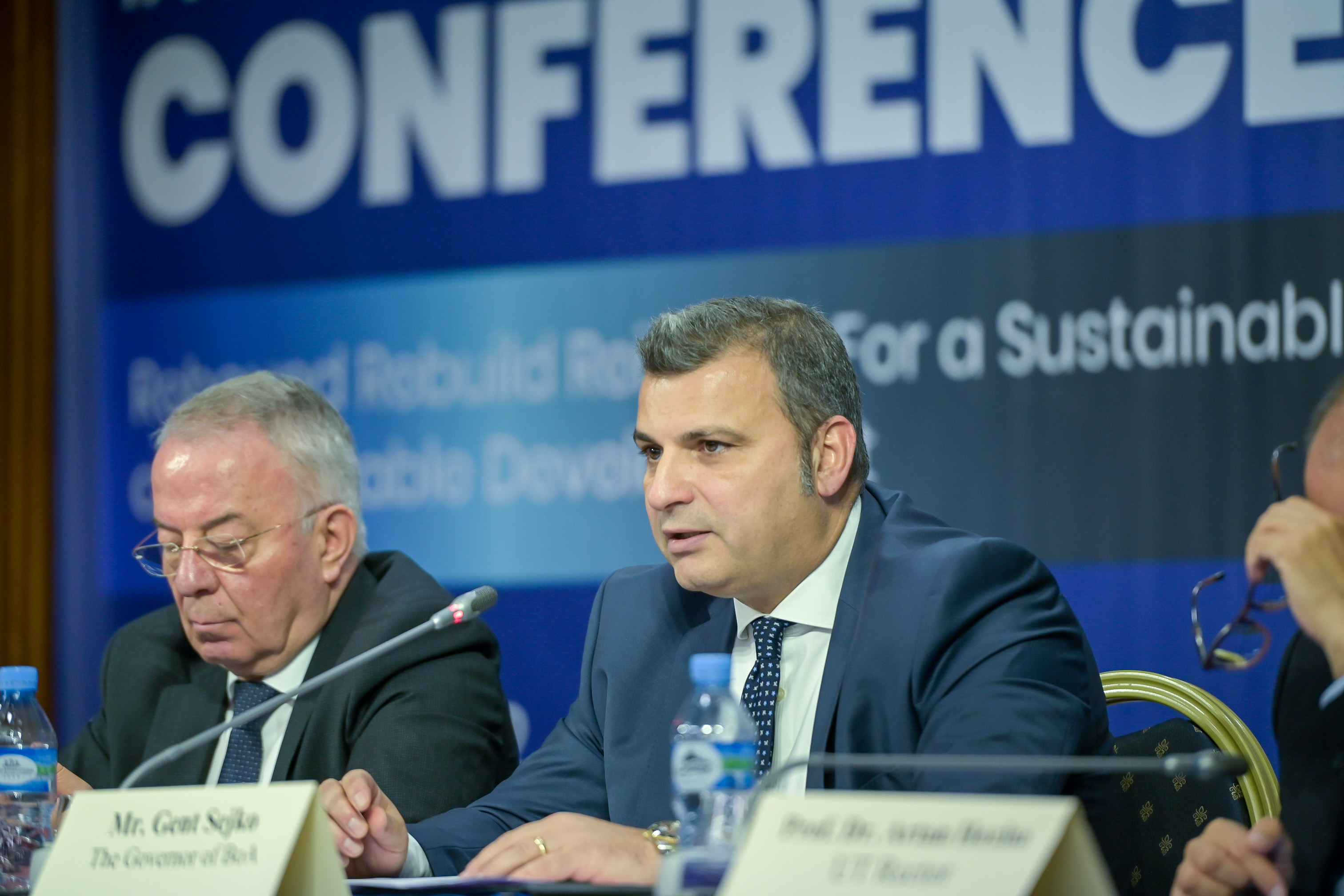BANK OF ALBANIA
Governor Sejko: Address at the International Conference “Rebound Rebuild Reinvent for a Sustainable and Equitable Development”
Publication date: 11.06.2022
Dear participants,
It is my greatest pleasure to attend today's conference where we will discuss the latest global market developments, and their impact on both the economy and monetary policy of the Bank of Albania.
Before commencing my speech, I would like to extend my gratitude to the organizers of this conference. In the 65th anniversary of the Faculty of Economics, the Bank of Albania and other institutions, should feel honoured that they share a common history with this faculty and that their respective missions are interconnected.
This faculty is the earliest institution which has provided economic education in Albania, while having significant impact on the Albanian prosperity and identity. In the course of its history, the best economists have graduated from this faculty. Their contribution is substantial to the development of economic and financial policies in Albania. As a result, I am convinced that the track record of the faculty's academic development goes parallel to the economic development of Albania.

Honourable guests,
The selected topic is both relevant and visionary. The economic and financial developments in the last decade, particularly the shocks of the past two years, have engendered major changes to central banking, notably in regards to monetary policy and banking regulation and supervision.
I would like to use this invitation to share with you the Bank of Albania’s vision on future challenges and their impact on the objectives, strategies and instruments that central banks will adopt in the future.
For the sake of being as much comprehensive and succinct as possible during my discussion, I would focus on three main topics: (i) first, I would like to share with you the current state of the monetary policy development at the Bank of Albania, and its connection to banking supervision and banking regulation; (ii) second, I will show our experience with the two crises of the previous decade, in order to identify their impact on the course of action and thinking process of the Bank of Albania over time; and (iii) third, I will shortly dwell on the role of the Bank of Albania and its contribution on the macroeconomic stability over the last years. In conclusion I will briefly discuss the extrapolated lessons and future challenges.

Let me address the first topic of discussion.
1. The Bank of Albania as a promoter of stability and development
The Bank of Albania is the monetary authority of the Republic of Albania. Its primary legal mandate is to achieve and maintain price stability in congruence with the best global practices. This mandate is based on a broad academic and practical consensus, which decrees that maintaining price stability is central bank's most essential contribution to the stable growth of life standard. The stability of prices is a preliminary condition to meet the three classical functions of money, as: a medium of exchange, storage of value and unit of account. Therefore, a stable monetary environment supports the economy, enterprises and households to confidently plan their income, consumption, investments, and savings, thus increasing the transparency of the economic system and the efficiency of resource allocation. In practice, price stability in Albania is defined as the inflation target, set at 3%.
However, this target is achievable if the banking and financial system is stable, balanced and efficient. Also, global experience shows that a necessary, albeit insufficient requirement for a stable financial system, which is able to efficiently carry out its task of financial intermediation and payment instrument provider, is a stable monetary environment. As a result, the Bank of Albania has also adopted a set of secondary objectives, which focus on the normal functioning of the banking sector and the money market. The fulfilment of these objectives is conducive to the financial stability of Albania and offers the second instrument which helps central banks to reach society’s long-term well-being.

The Bank of Albania has adopted the inflation targeting monetary policy regime. This regime, broadly adopted by central banks, consists of three main elements.
- First, it means that the central bank uses all the relevant data available to assess the balance of inflationary pressures. The traditional Philips curve for a small and open economy like Albania, considers this balance as a function of three components: the cyclical position of the economy; price pressures springing from the external market; and, partially, rational expectations of economic agents on inflation. In practice, this data is translated in price performance projections in the medium-term, which allows the central bank to identify possible deviations of inflation from the target, and take the necessary measures in a timely manner.
- Second, inflation targeting signifies that the central bank intervenes in the financial system by employing indirect instruments, which follow market's logic. In practice, central banks set the policy rate, which guides the entire spectrum of interest rates across all the ranges of financial market instruments.
- Third, it implies a free-floating exchange rate regime in accordance with the demand and supply ratio for foreign currency. This allows the monetary policy to entirely focus on meeting the price stability objective, simultaneously providing the economy with an instrument to buffer against shocks that might originate from the external environment.
In addition to these classical elements, the Bank of Albania adopts a flexible regime of targeted inflation. This means that in the process of assessing the monetary policy stance, the Bank of Albania considers the cyclical position of the economy as well. Also, the function of monetary policy reaction gives a specific weight to cushioning the business cycles, naturally without losing sight of meeting price stability at any time.
In accordance with these features, the Bank of Albania has undertaken a public engagement to implement a consistent and stable monetary policy. Consistency requires our monetary policy stance to be the proper one at any given time, so that we can meet our inflation target within the medium-term horizon. Stability demands our monetary policy to also be a factor in elements of risk and uncertainty, which are inseparable parts of the economic forecast process and ever-present in the activity of financial markets.

To focus on the latter, I would like to emphasize that the Bank of Albania's strategy on meeting inflation target, is based both on best central banking practices and the stage of development of the Albanian economy and financial markets. As a result, we give due attention to the assessment of monetary policy transmission mechanism, as well as the stability of the banking and financial system.
As a supervisor and regulator of the banking system, the dominant position of the banking system in the Albanian economy gives the Bank of Albania a unique perspective on the transmission mechanism of monetary policy and its interaction with the banking regulation - in other words - the macroprudential policy.
Although the efficient interconnection between the monetary and macroprudential policy remains an area without a clear academic and practical consensus, we have derived important lessons from our experience over the last decade.
The global financial crisis and the debt crisis in the Euro area were wake-up calls, pointing out the need to evaluate the interconnection between the monetary and financial stability. These crises shed light on the importance that a stable banking and financial system have on the overall stability and development. Prior to these crises, the philosophy of economic management was led by a silent assumption that monetary stability was, in and of itself, sufficient for the overall economic and financial stability. The financial markets were deemed efficient and self-regulatory, which implied a lack of systemic financial crises. The 2008 financial crises was a huge shock which overturned these consensus. The worsening balance sheets of the banking sector, an increase of uncertainty, and the suspension in the circulation of financial flows hindered the normal monetary policy transmission.
In advanced economies, central banks forcefully reacted to support the economy and financial system stability. The rates rapidly went down to 0, shifting into the negative territory as well. However, the issues related to the transmission mechanism required them to adopt and apply unconventional monetary policy instruments. Quantitative and credit easing re-established, up to a certain degree, liquidity circulation in the economy, by surpassing financial intermediaries - banks and capital markets. Nonetheless, it resulted in a rapid expansion of the central banks’ balance sheets and pushed them in an area unexplored by the monetary policy.
On the other hand, the use of this instrument in Albania and across the region was rendered inadequate, due to the low level of financial market development. Under these circumstances, our attention was focused on identifying the consequences of the shock on the banking sector and drafting a strategy of measures to address them as quickly as possible.
In the second session, I will address the Bank of Albania’s experience with the financial crises and the lessons learned.

2. The lessons derived from the financial crises of the late 2000s and early 2010s.
Albania and the Western Balkans experienced a decade of rapid and stable growth in the outbreak of the global financial crisis. The economic liberalisation in the beginning of the nineties, the ever increasing integration with advanced economies and markets of the European Union, the rapid productivity growth as a result of the introduction of foreign capital and expertise, as well as the comprehensive structural and institutional reforms, put the region on the fast development trajectory. Overall, the economies of the region advanced and left behind the status of “economies in need” and gained a new status, that of emerging economies, characterised by solid growth prospects and convergence with the European Union.
The global financial crisis changed almost every aspect. Although Albania and the regional countries had a relatively low economic and financial exposure to the USA - the country where the crisis originated - its consequences were strongly felt in the region.
The contraction of global financial conditions and the reduction of external demand were coupled with several weaknesses of our economic and financial development model. This initial shock was quickly followed by the sovereign debt crisis in the Euro area. This shock was as serious and persistent as the global financial crisis. In particular, it caused a rapid outflow of banking capital and financial funds outside the region, which made it harder for policy-makers to react while trying to manage the consequences of the crisis.
In a few words, the consequences of these shocks were the worsening of the financial balance sheets of the public and the private sector, as well as a decade when the pace of economic growth almost halved compared with the pre-crisis period, while inflation remained below the central bank's target.
Allow me to briefly explain the features of the Albanian and the regional development, which exacerbated the consequences of the shock and the challenges we faced.
First, the economic growth model clearly veered toward domestic consumption and investments, particularly investments in the sector of residential construction. This model encouraged a non-competitive economic structure. It caused an excessive allocation of economic and financial resources in the construction sector and an unjustified increase of asset prices. The reality that we faced following the last two financial crises, emphasized the role of structural reforms as the main promoter for a stable and long-term development of the country, which also required time to collect its fruits. Also, in the central bank's view, it brought to attention the considerable role of asset prices as indicators of economic imbalances, their implications on financial stability, as well as the long time required to address them.

Second, the fast economic growth was nurtured by foreign financial flows, generally intermediated by the banking sector. This process was facilitated by ample bank equity originating from the EU countries and the region, as well as the structure of their incentives and business model. Within the banking sector, the major consequences of the crisis were the rise of non-performing loans, particularly in the segment of loans in foreign currency, and the declining attention of the European banks on the region. Not least, the high level of non-performing loans in the segment of borrowers in foreign currency unhedged from the exchange rate risk, restricted the freedom of action of monetary policy and hindered the use of exchange rate as a shock absorber.
As a result of these issues, the functioning of the monetary policy's transmission mechanism was not optimal. The Bank of Albania addressed them by engaging in a comprehensive programmes of measures to:
- lower the level of NPLs and improve the lending environment. In addition, special attention was paid to the improvement of risk management systems within commercial banks;
- consolidate the banking sector, substituting some foreign banking groups, which reviewed - voluntarily or not - their strategies of expansion in the region, with young motivated investors;
- reduce the use of the euro in the financial sector. This action aims at reducing the unnecessary use of the euro for both savings and loans, notably in the segment of borrowers unhedged against the exchange rate risk.
Third, imbalances in the financial sector were driven by the inability of public regulators to fully discipline the quantity and destination of financial inflows, as well as the inattentiveness of foreign regulators toward these developments. Consequently, after the pandemic period, the Bank of Albania carried out a full convergence programme of its supervisory and regulatory framework with the requirements of the Basel Committee and the European Union standards. To corroborate our work, an independent assessment conducted during last year demonstrated a high scale of convergence between our regulatory framework and supervisory policies with the ones of the European Union. In parallel to them, we have intensified the dialogue with foreign supervisors, in order to spot issues in a timely manner and devise - when possible - common intervention policies.
Forth, when Albania entered the global financial crisis, it had one of the highest level of public debt in the region. This feature, coupled with an exorbitant increase of financial costs in foreign markets during the following period, contracted the space for a countercyclical fiscal stimulus. This challenge brought to the fore the importance that a low-level and controlled public debt has in preserving the fiscal space to respond, as well as the overall stability of the financial system.
In this context, of the three potential instruments of intervention of the government in the economy - monetary policy, macroprudential policy, and fiscal policy - the cost burden from the two financial crises of the previous decade, fell on monetary policy alone. Furthermore, this policy had a limited action space due to the negative consequences that a strong monetary policy could have had on financial stability. It also had to deal with a mechanism of transmission that was not fully functional.
While these issues dragged-out the aftermath of the shock, I must point out that Albania and the Bank of Albania were quick to identify them and provide the necessary institutional response.
The timely and energetic implementation of these reforms has increased the stability of the banking sector against shocks and improved the transmission mechanism of the monetary policy, noticeably helping our response in the following two crises.
3. The Bank of Albania against the pandemic and supply-side shocks
The pandemic and the Russian invasion of Ukraine are among the most serious shocks of the past decade. Although these two events are diametrically opposite shocks - the first being a demand-side shocks, while the second a proper supply-side one - their intensity tested the economic and financial balances of Albania and continues to do so. Fortunately, compared to the previous two shocks, we were prepared.
The response of public authorities toward the economic sphere, over the pandemic period, was an example of success. The situation demanded a quick, balanced, and coordinated response, aiming at both cushioning the impact of the shock in the short run, as well as minimizing the damage on the production capacity of the country, over the long run. The latter entails the minimisation of massive bankruptcies of businesses, the reduction of long furloughs, and, first and foremost, the preservation of the overall economic and financial stability of Albania.
The Bank of Albania launched a package of monetary, macroprudential, supervisory, and operational measures, which aimed at persevering financial markets’ liquidity, reducing the costs of borrowing, and maintaining a uninterrupted flow of crediting and financial services. Our immediate and multi-dimensional reaction allowed: (i) for the reduction of borrowing cost and the continuous support to households and enterprises with bank loans (ii) the banking system to be liquid, well-capitalised, and equipped with robust practices for risk management; and (iii) for the reduction of uncertainty and higher trust for the future. Over 2021, economic recovery was solid; growth sources as well as its supportive factors, not least the stable monetary and financial environment, were broadly-based.
In my point of view, success is dedicated to several factors:
- first, we were prepared. The lessons derived following the global financial crisis and the European sovereign debt crisis served to reduce the structural weaknesses of the economy, strengthen the financial sector, and increase its resilience against shocks;
- second, the response of policies was proportional to the complexity of the situation, speedy and coordinated. We activated a broad range of instruments, of unprecedented magnitudes. Monetary stimulus was simultaneously implemented with fiscal stimuli - sovereign guarantee funds - and with targeted regulatory and macroprudential accommodations.
- third, the response and the coordination of global policies were supportive in restricting the magnitude of economic downfall. The international financial institutions and the organisations and institutions of the EU took an active role in encouraging the coordination of global policies. For us, the policy-makers of the region, this ensured the international support for expansionary policies within the country, and helped in enlarging the play field.
However, the challenges remain present. The war in Ukraine has engendered a fast inflation hike across the world. In response to it, in March the Bank of Albania undertook the first step toward the normalisation of the monetary policy, increasing the policy rate by 0.5 percentage point. At the same time, we have demonstrated our will and availability to undertake any necessary monetary measure to avoid the spillover of this shock to a higher inflationary expectations in the future. Our transparent communication has been necessary to clarify the public on the monetary policy forward guidance and has helped to contain inflationary expectations in financial markets.
4. Conclusions
Dear participants!
In conclusion of my speech, allow me to share with you some lessons that the Bank of Albania has derived in face of the crises experienced over the years.
Price stability is a preliminary condition for a stable growth in the long term and the well-being of the people. In general, this stability should be the only legitimate objective of monetary policy. However, focusing on price stability shall not divaricate central bank’s attention from other sources of weaknesses and risks. In particular, financial stability should be another complementary objective of central banks, as long as it provides price stability and the efficient distribution of funds to the economy.
For a successful monetary policy, it is essential to adopt a contemporary framework. Nonetheless, this framework must have transparent objectives; use a comprehensive range of data; be consistent in the decision-making process, and flexible in adopting the operational framework. In this context, the most recent experience has shown that central banks must pay attention to the non-conventional instruments of monetary policy, such as quantitative and credit easing. However, these instruments are to be considered as options of last resort, and their use shall be conditioned by the stage of development and sophistication of financial markets.
As regards the central bank's aspect of financial stability, it must adopt - like monetary policy - an approach steered toward the future and a proactive stance. Although our role as supervisors and regulators cannot and should not be the guarantor of the soundness of every financial intermediation, systemic weaknesses which are premises for financial and economic crises, must be identified and handled in due time.
In parallel with them, the latest experiences have shown that fiscal policy has an irreplaceable role in dealing with strong economic and financial shocks. In spite of the strength and complexity of the instruments possessed by the central bank, it cannot stand alone and efficiently face the shocks delivered to small and opened economies. As a result, the soundness of public finances should be considered a significant indicator of the country's ability to withstand crises.
Overall, these considerations will determine the philosophy of thought and action of the Bank of Albania in the future. Nonetheless, I find it appropriate to highlight that a responsible central bank should not be satisfied by analysing the past to use is as a guide for the future. New challenges are visible over the horizon, such as financial innovation, global warming, an ageing population or adjustments to the business model borne by geopolitical tensions, and they should be appropriately addressed.
I am convinced that the discussions in this conference will shed more light on the issues and challenges that I elaborated on.
Thank You!

 Twitter
Twitter
 Youtube
Youtube
 Facebook
Facebook
 Flickr
Flickr
 RSS
RSS
 Subscribe
Subscribe
 Feedback
Feedback